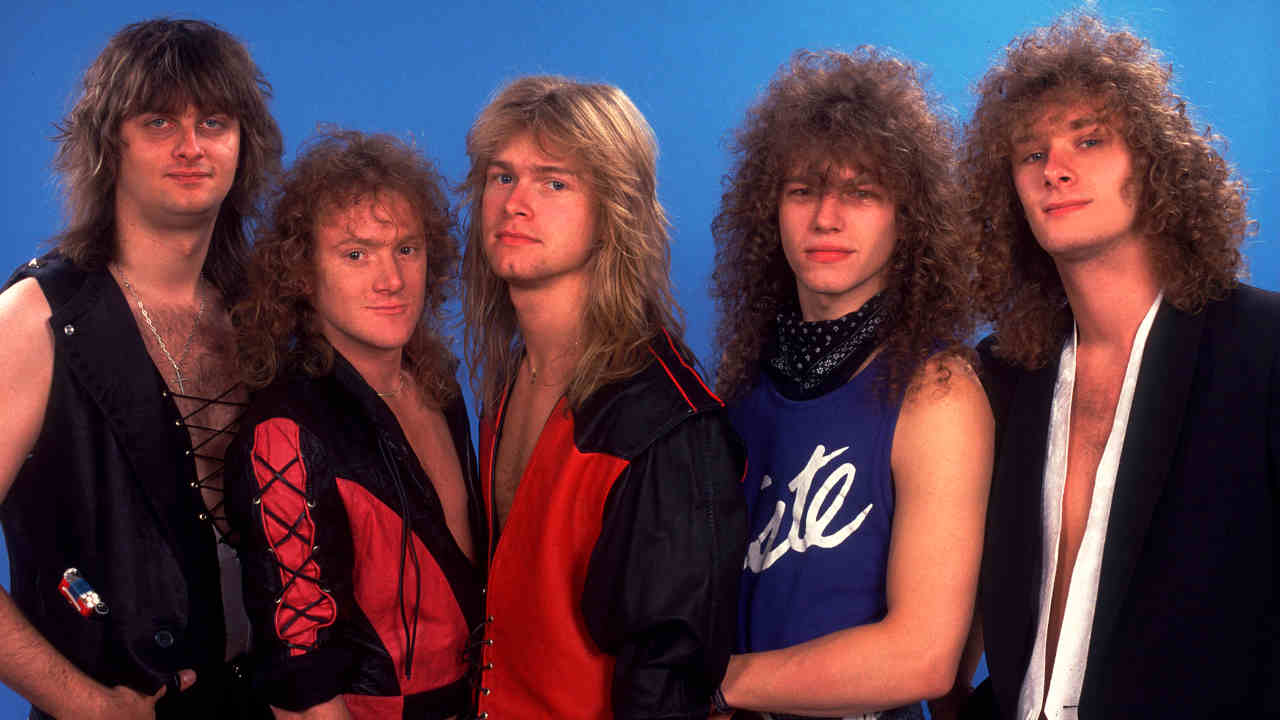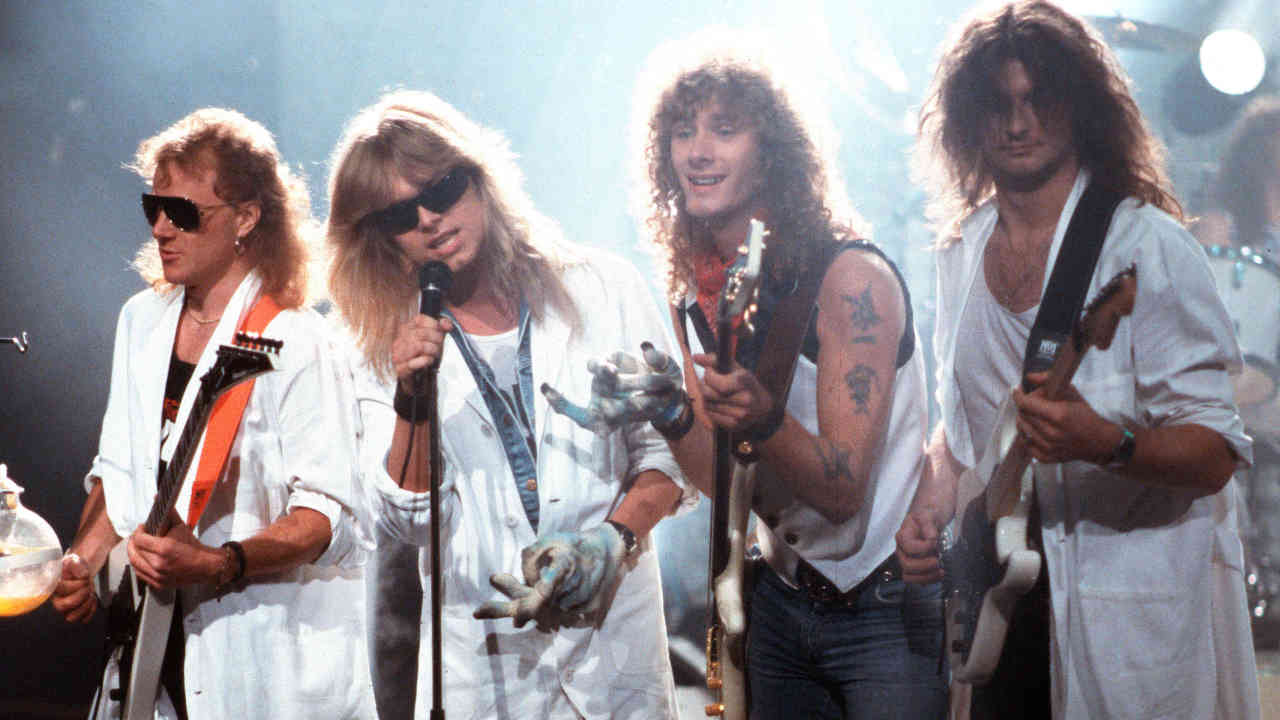
The 80s saw metal splintering into several exciting new subgenres: thrash, death metal, industrial. And in Germany, a former thrash band called Helloween drew up the blueprint for power metal as we know it with two albums that would briefly turn them into metal’s Next Big Thing: Keeper Of The Seven Keys: Part I and Part II.
“We knew we had come up with something special,” says Kai Hansen, Helloween’s founding guitarist. “They were records which we knew would make an impact – take us to the next level.”
The roots of Helloween dated back to 1979, when Hansen and fellow guitarist Piet Sielck formed a band called Ironfist in their native Hamburg. The line-up was completed by Ingo Schwichtenberg on drums and Markus Grosskopf on bass. After Sielck left to become a sound engineer, he replaced by former Powerfool guitarist Michael Weikath.
By 1984, Ironfist had changed their name to Helloween and bagged a spot on the misleadingly-titled compilation Death Metal, released via soon-to-become influential German label Noise Records. The two tracks they contributed, Oernst For Life and Metal Invaders, together with the following year’s Helloween EP and Walls Of Jericho album, established their sound – something Hansen describes as “Iron Maiden on speed”.
Hansen had doubled up on vocal duties to that point, but he was feeling overstretched. He knew Helloween needed something extra. “The guitar parts were getting more and more demanding, and I really had to concentrate on that part of what I did for the band,” he says. “Trying to perform live was getting tough for me, so it was decided that we needed to bring in another singer.”
After an extensive search, 18-year-old powerhouse vocalist Michael Kiske – formerly of German band Ill Prophecy– was drafted in, though Hansen had his doubts at first. “What he did seemed too soft for Helloween,” the guitarist admits. “My vocals were rougher. More heavy metal. And I just didn’t see Michael fitting in. But slowly he won me over. I came to understand what he could give to this band.”

Kiske’s arrival cemented what would become the classic Helloween line-up. Hansen and Weikath, the band’s chief songwriters, had amassed a hefty stash of songs. Invigorated, they cooked up a bold plan for the next album.
“We wanted to do a double,” says Hansen. “Seriously, we had the songs and the concept in place. No modern metal band had ever done a double studio record before, and we desperately wanted to be the first. But our label, Noise, were completely against it. We fought them really hard, and tried to persuade everyone what a great idea it was. But in the end, we lost. Such a shame, as I felt the project lost something.”
Instead, the band and the label elected to release two separate albums a year apart. The original plan was to mix up Hansen and Weikath’s songs across the two albums.
“But then it was suggested that the first album should feature mostly my stuff with Michael’s songs dominating the second one,” says Hansen. “The reason was that my style was more along the lines of the classic Helloween approach – very much rooted in our past – whereas Michael had a slightly more comic approach to his songs. I suppose these pointed to where the band were heading.”
The new songs they had written had pretty much jettisoned the thrash leanings of Walls Of Jericho. Inspired by the likes of Queensryche, the band were aiming for something more ambitious and complex, embodied by the twin 13-minute epics Halloween and Keeper Of The Seven Keys, which ended up as the respective centrepieces of the Part I and Part II albums.
“We were keen to make sure people realised there was a conceptual element to the albums,” says Hansen. “It wasn’t as if we’d come up with a story first and then tried to fit in all of the songs. We just noticed that some of the songs Michael and I had written separately – specifically Keeper Of The Seven Keys and Halloween – had a recurring theme. It was one of good and evil, heaven and hell, god and the devil, all battling it out. The Seven Keys were the way in which you could lock up the evil in the world.”
If the concept was a little clichéd, the music was anything but. Songs such as I’m Alive, Future World, Eagle Fly Free and I Want Out married the exhilarating energy of thrash to the grandiose power and epic melody of trad metal. Both albums were recorded at Horus Sound Studios in Helloween’s hometown of Hamburg, though their method was unusual.
“We had two producers working with us, Tommy Newton and Tommy Hansen,” explains Hansen. “I got on well with Newton, while Michael seemed to forge a natural alliance with Hansen. Newton and I worked in the studio during the day. Michael got up about 10pm and worked through the night. So we effectively had two completely separate production teams on the records. But it turned out to be useful. Most of the songs on the first album were mine, so I took command of them and Michael just added touches here and there. And the roles were reversed for the next one.”
The Hansen-led Keeper Of The Seven Keys: Part I was released in May 1987 to critical acclaim. Helloween were being held up as the band to lead metal into a new era. Part II, featuring more of Michael Weikath’s material, followed in August 1988 to an equally rapturous reception.
“It was obvious that, with me writing the majority of the first record, that the style would be more classical Helloween,” says Hansen. “Michael had the bigger role on Part II, so what we got was an album with lots of overdubs and keyboards – very different. It’s not that I don’t feel there’s quality in the songs, but when you listen to [the Weikath-penned, Frankenstein-inspired single] Dr. Stein… well, it’s just silly.”
Still, the one-two of the Keeper… albums had positioned Helloween as the heirs to Scorpions and Accept as the kings of German metal. Their ascent was rubber-stamped in August 1988, when they appeared on the bill of that year’s Monsters Of Rock festival at Castle Donington, alongside Guns N’ Roses, Megadeth, David Lee Roth, Kiss and headliners Iron Maiden. It was the biggest show they’d ever played – the official capacity was around 100,000, but estimates suggest there were as many as 120,000 people there (sadly, two fans were killed in the crush as the crowd surged during Guns N’ Roses early afternoon set).

Hansen himself enjoyed Helloween’s Donington appearance (“It remains among the highlights of my career”), but he wasn’t happy with the band’s trajectory - something compounded by a dispute with their label, Noise, over record and merch royalties.
“Everything was being pushed forward too fast for my liking,” he says. “I wanted to take things steadier. But the management and the record label wanted to speed ahead. We just finished a tour of America, I was exhausted and they sent us straight to Japan. I got hepatitis, and at that point I knew that I’d had enough of the whole thing. I had to get out.”
The guitarist had made his feelings clear on the Keeper Of The Seven Keys: Part II track I Want Out. “I want out/To do things on my own,” sang Michael Kiske, giving life to Hansen’s discontent.
“Yes, I did write it about my frustrations with the band, that is absolutely true,” he says. “It was the only way I thought I could make my feelings known. I was becoming alienated and didn’t much care for the direction Helloween were going in.”
Hansen made good on his promise. In January 1989, the guitarist quit the Helloween. He would go on to form a new band, Gamma Ray, with his place in his former outfit taken by guitarist Roland Grapow.
Helloween would continue without him. Their first post-Hansen album, 1991’s risible Pink Bubbles Go Ape, was an epic mis-step, and by the mid-90s, the line-up which recorded the Keeper Of The Seven Keys albums had splintered – Michael Kiske and drummer Ingo Schwichtenberg both left in 1993 (tragically, the latter committed suicide two years later, after struggling with severe mental health issues).
Michael Weikath and original bassist Markus Grosskopf continued with a reconfigured line-up featuring singer Andi Deris and a series of guitarists and drummers, releasing a string of albums that, while decent, never matched the two Keeper… records (one, 2005’s Keeper Of The Seven Keys: The Legacy, was intended as a sequel to the originals). Hansen ploughed his own furrow with the long-running Gamma Ray, plus Iron Savior and Unisonic, the latter of which found him reuniting with ex-Helloween singer Michael Kiske.
Then in 2016, the unexpected happened. After years of insisting a reunion would never happen, Hansen and Kiske joined forces with the Weikath-led band for an expanded Helloween line-up. A new album, simply titled Helloween and featuring both Michael Kiske and his own replacement Andy Deris, was released in 2021. Today, Helloween’s place as the fathers of modern power metal is secure thanks to Keeper Of The Seven Keys: Part I and II.
“They were very important albums, not just for us, but also in the history of heavy metal,” says Hansen. “I’m proud to have been involved.”
Originally published in Metal Hammer 142. Updated in May 2024







